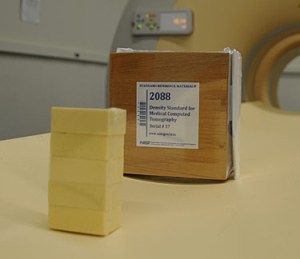Jul 25 2013
Scientists at the National Institute of Standards and Technology (NIST) have developed a new standard reference material (SRM), the first such measurement tool to enable hospitals to link important tissue density measurements made by CAT scans to international standards.
 Standard Reference Material 2088 makes it possible to link CAT scans to the International System of Units for the first time. The SRM - a collection of five blocks of polyurethane foam of different densities, shown here in front of its delivery case - allows scans to be tied to measurement units important for diagnosing lung disease. Credit: Boutin/NIST
Standard Reference Material 2088 makes it possible to link CAT scans to the International System of Units for the first time. The SRM - a collection of five blocks of polyurethane foam of different densities, shown here in front of its delivery case - allows scans to be tied to measurement units important for diagnosing lung disease. Credit: Boutin/NIST
Computed tomography ("CT" or "CAT") uses computer processing to combine multiple X-ray images into three-dimensional scans that resemble slices of the body. These cross-sections are useful for spotting changes that are difficult to discern from ordinary two-dimensional X-ray images alone, such as the changes in lung tissue that indicate cancer or emphysema. Millions of CAT scans take place every year in the U.S. alone, but over time, the devices' outputs have a tendency to "drift," according to NIST physicist Zachary Levine.
"Scanners are calibrated daily, but over periods of months you still see variations," says Levine. "Some of these come from the physical degradation of the machine, or even from changes made by software upgrades. Doctors "get to know" their own machine's idiosyncrasies and make good diagnoses, but they'd still like to be more certain about what they're seeing, especially when it comes to lung tissue."
Calibrating a CAT scanner is not difficult in principle. All that is needed are physical objects of known density that can be run through the scanner together with a patient so the scan shows both the patient and the reference. Finding an appropriate material was a bit challenging though. Lung tissue is among the lightest in the body, and varies constantly in its density depending on how much air is trapped in it.
A lung tissue SRM must span a range of densities not only for this reason, but for diagnostic purposes as well. While emphysema makes lung tissue grow less dense, in a tumor the density increases. Scientists who work on CAT scans often express this density range as a "CT number," where a change in CT number by a few points can mean the difference between one diagnosis and another.
SRM 2088, a collection of five small blocks that the NIST team fashioned from polyurethane foam of different densities, makes it possible to link scans to the International System of Units (SI) for the first time. Together with a second reference material (SRM 2087) developed last year, SRM 2088 allows CAT scans to be tied to SI units for length, density and mass attenuation coefficient—three characteristics that are particularly important for diagnosing lung diseases effectively.
The NIST team chose polyurethane foam, which Levine says is ideal because it is both inexpensive and available off the shelf in an appropriate range of densities corresponding to the density range of lung tissue. The SRM needed to be accurate to within 10 CT numbers to be useful, and density tests indicate that they are accurate to within 0.15 CT numbers, roughly 100 times more than necessary.
SRM 2088, "Density Standard for Medical Computed Tomography" and SRM 2087, " Dimensional Standard for Medical Computed Tomography" are available from the NIST Standard Reference Materials office at www.nist.gov/srm/.